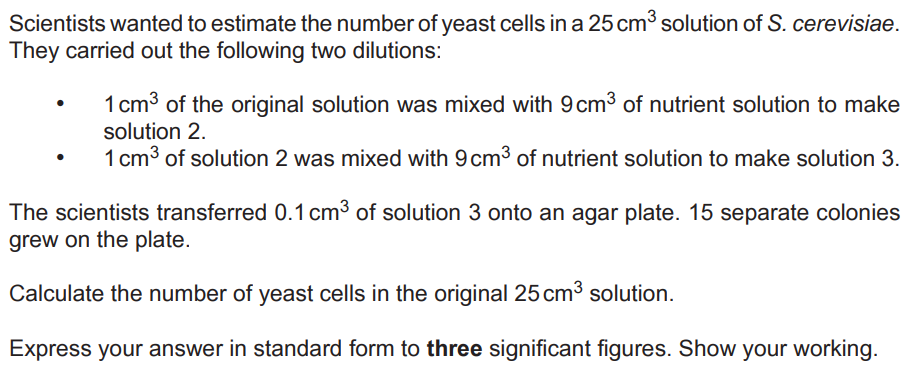Challenging maths skills in A Level Biology
14 May 2021
Andri Achilleos, Biology Subject Advisor

Mathematical skills in A Level Biology can sometimes cause anxiety to both students and teachers. Data analysis from past exams, showed that students score low marks or omit questions on topics such as serial dilutions and logarithms. Those two topics seem to be difficult for biology teachers as well as students as we’ve received several queries in the past. In this blog I have identified some online resources that are easy to follow.
1. Serial dilutions
The ‘Microbenotes’ website gives an excellent introduction to the subject. It describes the objectives of serial dilutions and explains how you can calculate the dilution factor.
A series of YouTube videos from Saint Joseph’s University explain dilutions with notes and PowerPoint slides. The first video explains how you can calculate the concentration for each serial dilution using the dilution factor. This is followed up by another video which explains how you can calculate colony formation units, by looking at microorganisms’ colonies on agar plates.
Serial dilutions can be applied in different contexts and it’s important to practice using past paper questions. The easiest way to do this is using ExamBuilder. Here is an example from our June 2017 exam paper (H420/03, Question 2biii):

In this question students must apply their knowledge and understanding of the basic principles of serial dilutions. Here are the steps that can be followed:
- The final dilution in solution 2 is 0.1 (1/10) and in solution 3 is 0.01 (1/10 x 1/10 = 1/100).
- An easy way to calculate the number of yeast cells in the original solution is using the equation below:
(Number of colonies / amount plated (ml/cm3)) x Dilution (no minus sign) = CFU/ml or cm3
(15/ 0.1cm3) x 102 (dilution from solution 3 used to plate) = 15000 colonies forming unit in 1cm3.
- Original solution contains 25cm3, so the total colonies are 15000 x 25 = 375000
- The answer is given in standard form to three significant figures, 3.75 x105.
2. Logarithms
Students may be tested on their ability to use a logarithmic scale in different contexts, for example calculating the growth rate of a microorganism. Logarithms are just another way of writing exponential equations. In this animation by TEDEd, Steve Kelly explains how logarithms are used and why they are useful.
In biology they are usually used to help us express very large or very small numbers. The YouTube video by ‘Don’t memorise’ describes how logarithms are used in real life applications and why is important to use them. You can find more support on the use of logarithms in our Maths skills handbook, page 43.
In question papers, logarithms can be used in different contexts. Here is an example from our June 2018 exam paper (H420/03, Question 4cii):

To calculate the number of fragments produced after 12 cycles in the PCR you will need to calculate 2^12 = 4096. To represent this number as a log value you will need to work out the log10 of 4096. Log10 4096 = 3.612. The answer will therefore be 103.61.
More support
For all the mathematical skills needed for the course you can find further support on our ‘Maths for Biology’ website. This site supports students and teachers, with tutorials for every maths skill. These resources can be used independently, and students can check their knowledge and understanding using the ‘Quiz’ activity.
Our maths subject advisor team has recently written a few blogs which might be useful as well:
How accurate is a mathematical answer?
Why is standard deviation not standard across subjects?
Hypothesis tests and the art of being non-assertive
Stay connected
If you have any comments or questions, you can email us at science@ocr.org.uk, call on 01223 553998 or tweet @OCR_Science. You can also sign up to subject updates to receive information about resources and support.
If you are considering teaching A Level Biology, use our online form to let us know, so that we can help you with more information.
About the author
Andri Achilleos was a teacher for ten years before joining OCR in January 2019 as the subject advisor for A Level Biology. She studied Biology at University of Bristol and completed an MA in Science Education at University of York. She has taught in Birmingham as Teacher in charge of Biology, as well as an international school in Europe. During her teaching career she has taken on various roles within the department and has also been an examiner for different exam boards.